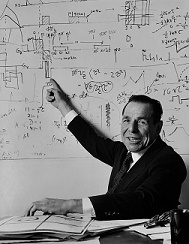
Jerome R. Singer
Professor of Engineering Science, Emeritus
Born in Cleveland, OH, on October 16, 1921, Jerome (Jay) Singer was the son of immigrants from Central Europe. Coming of age as World War II was beginning, he underwent maritime training and then served for four years as navigator on troop transport ships. He received his bachelor’s degree in mathematics from the University of Illinois in 1950, M.S. in physics from Northwestern University (IL) in 1953, and his Ph.D. in physics from the University of Connecticut in 1955.
After joining the University of California, Berkeley’s Department of Electrical Engineering (EE) in June, 1963, Jay worked on laser research, collaborating with Professors Shyh Wang, John Whinnery and Charles Susskind. He also began to pursue his notion that nuclear magnetic resonance (NMR) could be employed to measure blood flow noninvasively. On December 11, 1959, Jay’s research report, “Blood Flow Rates by NMR Measurement,” appeared in Science [Vol. 130 (3389):1652-1653]. This was only nine years after Erwin Hahn first detected spin echoes and free induction decay, the phenomena exploited in Jay’s work. The year 1959 also was when Vladislav Ivanov filed the first patent application for an imaging scheme based on Hahn’s work. Ivanov’s patent application was a first step along the path that eventually would lead to the static three-dimensional NMR imaging in modern medicine. Jay’s discovery would add the fourth dimension—time. Eventually it would earn him a nomination for the Nobel Prize. It also thrust him into the bioengineering and biophysics communities.
He became active in the UC Berkeley Graduate Group in Biophysics and, with Charles Susskind and Irving Fatt, in the establishment of a graduate bioengineering training program at UC Berkeley. As the EE department was becoming the Department of Electrical Engineering and Computer Sciences (EECS) in 1973, Jay helped establish an undergraduate bioelectronics option for the expanded department’s undergraduates. He was also appointed adjunct professor of radiology at UC San Francisco. His work on blood-flow measurements with NMR continued through his retirement from Berkeley in June, 1984, and beyond. Along the way, he made major contributions to three-dimensional MRI as well as to quantification of blood flow in the human body, employing the NMR procedures that he had invented 15 years before the publication of the first paper on MRI imaging. Among those contributions were the introduction of superconducting magnets into MRI systems and his founding of a company (Alpha Scientific Laboratories, Inc., now Alpha Magnetics Inc.) to manufacture high-quality magnets. He was a prolific inventor: with his graduate students, he was awarded more than 20 patents.
Jay was married to Margaret Thaler Singer (1921–2003), a renowned clinical psychologist. He passed away on July 30, 2019. Jay is survived by his daughter, Martha Singer, M.D., his son, Sam Singer, and four grandchildren.
Edwin R. Lewis
Thomas F. Budinger
2019
